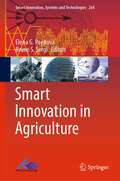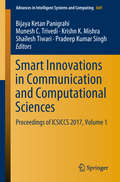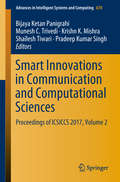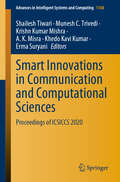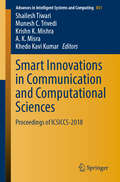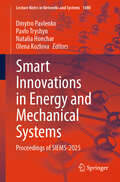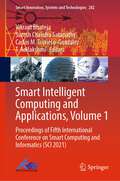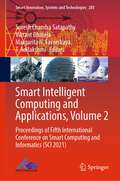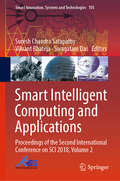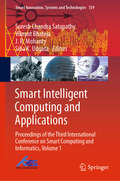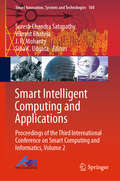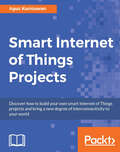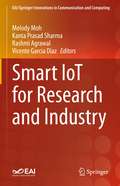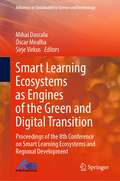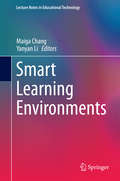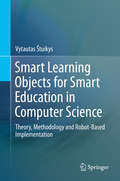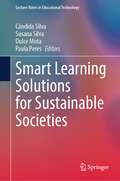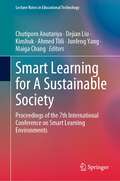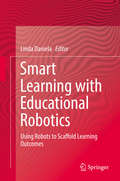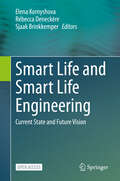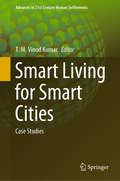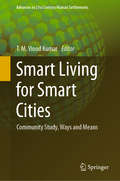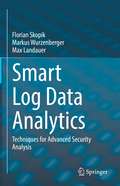- Table View
- List View
Smart Innovation in Agriculture (Smart Innovation, Systems and Technologies #264)
by Elena G. Popkova Bruno S. SergiThis book is concerned with the systemic examination of the prospects for the development of smart agriculture for sustainable development. This book substantiates the top-priority significance of smart innovation in agriculture for modern economic and ecological systems. The book not only examines the theoretical concept of smart agriculture, but also gives consideration to the rule of thumb in terms of its implementation in different countries worldwide. The book contains both fundamental and applied recommendations on the innovative technological development of smart agriculture in modern economic and ecological systems for sustainable development. The book is not limited to a single vector of development of smart agriculture, but is representative of all of them, making it possible to describe the future prospects in the fullest, most reliable and accurate manner, and to comprehensively present the directions for its development. The book has developed and applied an advanced and sophisticated methodology, the advantage of which consists in the reliance on big data with the use of datasets, which allows improving accuracy, reliability, authenticity, and coverage of results.
Smart Innovation of Web of Things (Internet of Everything (IoE))
by Manju Khari Aarti Jain Rubén González CrespoThe Web of Things (WoT) is a concept that describes approaches, programming tools and software architectural systems, which interface networks of real-world objects with the World Wide Web. The book is organized into 11 chapters, each focusing on a unique wireless technological aspect of the Web of Things, and it aims to comprehensively cover each of its various applications, including: A strong emphasis on WoT problems and solutions, identifying the main open issues, innovations and latest technologies behind WoT A blend of theoretical and simulation-based problems for better understanding of the concepts behind WoT Various exemplifying applications in which the use of WoT is very attractive and an inspiration for future applications The book will be useful to researchers, software developers and undergraduate and postgraduate students, as well as practitioners.
Smart Innovations in Communication and Computational Sciences: Proceedings of ICSICCS 2017, Volume 1 (Advances in Intelligent Systems and Computing #669)
by Bijaya Ketan Panigrahi Krishn K. Mishra Shailesh Tiwari Munesh C. Trivedi Pradeep Kumar SinghThe book provides insights into International Conference on Smart Innovations in Communications and Computational Sciences (ICSICCS 2017) held at North West Group of Institutions, Punjab, India. It presents new advances and research results in the fields of computer and communication written by leading researchers, engineers and scientists in the domain of interest from around the world. The book includes research work in all the areas of smart innovation, systems and technologies, embedded knowledge and intelligence, innovation and sustainability, advance computing, networking and informatics. It also focuses on the knowledge-transfer methodologies and innovation strategies employed to make this happen effectively. The combination of intelligent systems tools and a broad range of applications introduce a need for a synergy of disciplines from science and technology. Sample areas include, but are not limited to smart hardware, software design, smart computing technologies, intelligent communications and networking, web and informatics and computational sciences.
Smart Innovations in Communication and Computational Sciences: Proceedings of ICSICCS 2017, Volume 2 (Advances in Intelligent Systems and Computing #670)
by Bijaya Ketan Panigrahi Krishn K. Mishra Shailesh Tiwari Munesh C. Trivedi Pradeep Kumar SinghThe book provides insights into International Conference on Smart Innovations in Communications and Computational Sciences (ICSICCS 2017) held at North West Group of Institutions, Punjab, India. It presents new advances and research results in the fields of computer and communication written by leading researchers, engineers and scientists in the domain of interest from around the world. The book includes research work in all the areas of smart innovation, systems and technologies, embedded knowledge and intelligence, innovation and sustainability, advance computing, networking and informatics. It also focuses on the knowledge-transfer methodologies and innovation strategies employed to make this happen effectively. The combination of intelligent systems tools and a broad range of applications introduce a need for a synergy of disciplines from science and technology. Sample areas include, but are not limited to smart hardware, software design, smart computing technologies, intelligent communications and networking, web and informatics and computational sciences.
Smart Innovations in Communication and Computational Sciences: Proceedings of ICSICCS 2020 (Advances in Intelligent Systems and Computing #1168)
by Shailesh Tiwari Munesh C. Trivedi A. K. Misra Khedo Kavi Kumar Krishn Kumar Mishra Erma SuryaniThis book presents the latest advances and research findings in the fields of computational science and communication presented at the International Conference on Smart Innovations in Communications and Computational Sciences (ICSICCS 2020). The areas covered include smart innovation; systems and technologies; embedded knowledge and intelligence; innovation and sustainability; advanced computing; networking and informatics. It also focuses on the knowledge-transfer methodologies and the innovation strategies employed to make these effective. This fascinating compilation appeals to researchers, academics and engineers around the globe.
Smart Innovations in Communication and Computational Sciences: Proceedings of ICSICCS-2018 (Advances in Intelligent Systems and Computing #851)
by Krishn K. Mishra Shailesh Tiwari Munesh C. Trivedi A. K. Misra Khedo Kavi KumarThe book presents the latest advances and research findings in the fields of computational science and communication. The areas covered include smart innovation; systems and technologies; embedded knowledge and intelligence; innovation and sustainability; advanced computing; and networking and informatics. It also focuses on the knowledge-transfer methodologies and the innovation strategies employed to make these effective. This fascinating compilation appeals to researchers, academics and engineers around the globe.
Smart Innovations in Energy and Mechanical Systems: Proceedings of SIEMS-2025 (Lecture Notes in Networks and Systems #1480)
by Dmytro Pavlenko Pavlo Tryshyn Natalia Honchar Olena KozlovaThis book appeals to researchers and professionals working in the field of artificial neural networks. It offers insights into the application of neural networks in engineering contexts, providing valuable case studies and methodologies for those looking to bridge the gap between AI theory and practical engineering solutions. Engineers and technicians involved in additive manufacturing will find relevant content in this book. It covers advanced techniques and applications of 3D printing in aerospace and mechanical engineering, offering a unique perspective on how these technologies are shaping the future of manufacturing. The book caters to professionals and students focusing on machine learning and artificial intelligence, particularly in industrial applications. It demonstrates how these technologies are being integrated into energy systems and mechanical engineering, providing real-world examples and potential future directions. Robotics enthusiasts and engineers will benefit from the book's coverage of cutting-edge developments in industrial and aerospace robotics. It offers insights into autonomous systems, control algorithms, and the integration of robotics in smart manufacturing environments. Graduate and undergraduate students in STEM fields beyond traditional engineering, such as computer science or data science, will find value in the book's interdisciplinary approach. It showcases how advanced computational methods are applied to solve complex engineering problems. This book is of interest to enterprises that are involved in the implementation of green energy technologies, resource-saving technologies, and support the concept of decarbonization of the energy system.
Smart Intelligent Computing and Applications, Volume 1: Proceedings of Fifth International Conference on Smart Computing and Informatics (SCI 2021) (Smart Innovation, Systems and Technologies #282)
by Suresh Chandra Satapathy Vikrant Bhateja Carlos M. Travieso-Gonzalez T. AdilakshmiThe proceeding presents best selected papers presented at 5th International Conference on Smart Computing and Informatics (SCI 2021), held at Department of Computer Science and Engineering, Vasvi College of Engineering, Hyderabad, Telangana, India, during 17 – 18 September 2021. It presents advanced and multi-disciplinary research towards the design of smart computing and informatics. The theme is on a broader front focuses on various innovation paradigms in system knowledge, intelligence and sustainability that may be applied to provide realistic solutions to varied problems in society, environment and industries. The scope is also extended towards the deployment of emerging computational and knowledge transfer approaches, optimizing solutions in various disciplines of science, technology and healthcare. The work is published in two volumes.
Smart Intelligent Computing and Applications, Volume 2: Proceedings of Fifth International Conference on Smart Computing and Informatics (SCI 2021) (Smart Innovation, Systems and Technologies #283)
by Margarita N. Favorskaya Suresh Chandra Satapathy Vikrant Bhateja T. AdilakshmiThe proceeding presents best selected papers presented at 5th International Conference on Smart Computing and Informatics (SCI 2020), held at Department of Computer Science and Engineering, Vasavi College of Engineering, Hyderabad, Telangana, India, during 17 – 18 September 2021. It presents advanced and multi-disciplinary research towards the design of smart computing and informatics. The theme is on a broader front focuses on various innovation paradigms in system knowledge, intelligence and sustainability that may be applied to provide realistic solutions to varied problems in society, environment and industries. The scope is also extended towards the deployment of emerging computational and knowledge transfer approaches, optimizing solutions in various disciplines of science, technology and healthcare. The work is published in two volumes.
Smart Intelligent Computing and Applications: Proceedings Of The Second International Conference On Sci 2018, Volume 1 (Smart Innovation, Systems and Technologies #104)
by Swagatam Das Suresh Chandra Satapathy Vikrant BhatejaThe proceedings covers advanced and multi-disciplinary research on design of smart computing and informatics. The theme of the book broadly focuses on various innovation paradigms in system knowledge, intelligence and sustainability that may be applied to provide realistic solution to varied problems in society, environment and industries. The volume publishes quality work pertaining to the scope of the conference which is extended towards deployment of emerging computational and knowledge transfer approaches, optimizing solutions in varied disciplines of science, technology and healthcare.
Smart Intelligent Computing and Applications: Proceedings of the Third International Conference on Smart Computing and Informatics, Volume 1 (Smart Innovation, Systems and Technologies #159)
by J. R. Mohanty Suresh Chandra Satapathy Vikrant Bhateja Siba K. UdgataThis book gathers high-quality papers presented at the Third International Conference on Smart Computing and Informatics (SCI 2018–19), which was organized by the School of Computer Engineering and School of Computer Application, Kalinga Institute of Industrial Technology, Bhubaneswar, India, on 21–22 December, 2018. It includes advanced and multi-disciplinary research on the design of smart computing and informatics. Thematically, the book broadly focuses on several innovation paradigms in system knowledge, intelligence and sustainability that can help to provide realistic solutions to various problems confronting society, the environment, and industry. The respective papers offer valuable insights into the how emerging computational and knowledge transfer approaches can be used to deliver optimal solutions in science, technology and healthcare.
Smart Intelligent Computing and Applications: Proceedings of the Third International Conference on Smart Computing and Informatics, Volume 2 (Smart Innovation, Systems and Technologies #160)
by J. R. Mohanty Suresh Chandra Satapathy Vikrant Bhateja Siba K. UdgataThis book presents high-quality papers from the Third International Conference on Smart Computing and Informatics (SCI 2018−19), organized by the School of Computer Engineering and School of Computer Application, Kalinga Institute of Industrial Technology Deemed to be University, Bhubaneswar, from 21 to 22 December 2018. It includes advanced and multi-disciplinary research on the design of smart computing and informatics, focusing on innovation paradigms in system knowledge, intelligence and sustainability that have the potential to provide realistic solutions to various problems in society, the environment and industry. The papers featured provide a valuable contribution to the deployment of emerging computational and knowledge transfer approaches, optimizing solutions in varied disciplines of science, technology and health care.
Smart Internet of Things Projects
by Agus KurniawanDiscover how to build your own smart Internet of Things projects and bring a new degree of interconnectivity to your world About This Book • Learn how to extract and analyse data from physical devices and build smart IoT projects • Master the skills of building enticing projects such as a neural network autonomous car, computer vision through a camera, and cloud-based IoT applications • This project-based guide leverages revolutionary computing chips such as Raspberry Pi, Arduino, and so on Who This Book Is For If you are hobbyist who is keen on making smart IoT projects, then this book is for you. You should have a basic knowledge of Python. What You Will Learn • Implement data science in your IoT projects and build a smart temperature controller • Create a simple machine learning application and implement decision system concepts • Develop a vision machine using OpenCV • Build a robot car with manual and automatic control • Implement speech modules with your own voice commands for IoT projects • Connect IoT to a cloud-based server In Detail Internet of Things (IoT) is a groundbreaking technology that involves connecting numerous physical devices to the Internet and controlling them. Creating basic IoT projects is common, but imagine building smart IoT projects that can extract data from physical devices, thereby making decisions by themselves. Our book overcomes the challenge of analyzing data from physical devices and accomplishes all that your imagination can dream up by teaching you how to build smart IoT projects. Basic statistics and various applied algorithms in data science and machine learning are introduced to accelerate your knowledge of how to integrate a decision system into a physical device. This book contains IoT projects such as building a smart temperature controller, creating your own vision machine project, building an autonomous mobile robot car, controlling IoT projects through voice commands, building IoT applications utilizing cloud technology and data science, and many more. We will also leverage a small yet powerful IoT chip, Raspberry Pi with Arduino, in order to integrate a smart decision-making system in the IoT projects. Style and approach The book follows a project-based approach to building smart IoT projects using powerful boards such as the Raspberry Pi, Arduino, and the IoT chip.
Smart Internet of Things for Environment and Healthcare (Studies in Computational Intelligence #1165)
by Mourade Azrour Jamal Mabrouki Azidine Guezzaz Abdulatif Alabdulatif Fatima AmounasNowadays, the efficient sustainable systems are becoming more and more important for sustainable life either in urban and in rural environments. Despite the advances in technologies, it is always important to consider the environment where we live. Hence, the present book presents some recent and fresh works that deal with environmental problems including water quality, wastewater management, air pollution monitoring, renewable energy solutions, food security solutions, and so on. Besides, the book investigates different applications of Artificial Intelligence for previous environmental issues. This book is targeting junior researchers, graduate and graduate students, environmental specialists, and all people who want to learn more about recent advancement in environmental solutions.
Smart IoT for Research and Industry (EAI/Springer Innovations in Communication and Computing)
by Vicente Garcia Diaz Rashmi Agrawal Melody Moh Kanta Prasad SharmaThis book covers a variety of smart IoT applications for industry and research. For industry, the book is a guide for considering the real-time aspects of automation of application domains. The main topics covered in the industry section include real-time tracking and navigation, smart transport systems and application for GPS domains, modern electric grid control for electricity industry, IoT prospectives for modern society, IoT for modern medical science, and IoT automation for Industry 4.0. The book then provides a summary of existing IoT research that underlines enabling technologies, such as fog computing, wireless sensor networks, data mining, context awareness, real-time analytics, virtual reality, and cellular communications. The book pertains to researchers, outcome-based academic leaders, as well as industry leaders.
Smart Learning Ecosystems as Engines of the Green and Digital Transition: Proceedings of the 8th Conference on Smart Learning Ecosystems and Regional Development (Advances in Sustainability Science and Technology)
by Óscar Mealha Sirje Virkus Mihai DascaluThe book brings together the contributions of the 8th International Conference on Smart Learning Ecosystems and Regional Development aimed at promoting reflection and discussion on the relevance of smart learning ecosystems for regional development and social innovation (e.g., schools, campuses, working places, informal learning contexts) and on how the effectiveness of the relation of citizens and smart ecosystems can be boosted. This forum is interested in understanding how technology-mediated instruments can foster the citizen’s engagement with learning ecosystems and territories, namely by understanding innovative human-centric design and development models/techniques, education/training practices, informal social learning, innovative citizen-driven policies, technology-mediated experiences, and their impact. This set of concerns contributes to fostering the social innovation sectors and ICT, economic development, and deployment strategies alongside new policies for smarter proactive citizens.
Smart Learning Environments
by Yanyan Li Maiga ChangThis book addresses main issues concerned with the future learning, learning and academic analytics, virtual world and smart user interface, and mobile learning. This book gathers the newest research results of smart learning environments from the aspects of learning, pedagogies, and technologies in learning. It examines the advances in technology development and changes in the field of education that has been affecting and reshaping the learning environment. Then, it proposes that under the changed technological situations, smart learning systems, no matter what platforms (i. e. , personal computers, smart phones, and tablets) they are running at, should be aware of the preferences and needs that their users (i. e. , the learners and teachers) have, be capable of providing their users with the most appropriate services, helps to enhance the users' learning experiences, and to make the learning efficient.
Smart Learning Objects for Smart Education in Computer Science
by Vytautas ŠtuikysThis monograph presents the challenges, vision and context to design smart learning objects (SLOs) through Computer Science (CS) education modelling and feature model transformations. It presents the latest research on the meta-programming-based generative learning objects (the latter with advanced features are treated as SLOs) and the use of educational robots in teaching CS topics. The introduced methodology includes the overall processes to develop SLO and smart educational environment (SEE) and integrates both into the real education setting to provide teaching in CS using constructivist and project-based approaches along with evaluation of pedagogic outcomes. Smart Learning Objects for Smart Education in Computer Science will appeal to researchers in CS education particularly those interested in using robots in teaching, course designers and educational software and tools developers. With research and exercise questions at the end of each chapter students studying CS related courses will find this work informative and valuable too.
Smart Learning Solutions for Sustainable Societies (Lecture Notes in Educational Technology)
by Cândida Silva Susana Silva Dulce Mota Paula PeresThis book showcases research and project results on technology, smart learning, and sustainability education and analyzes smart learning solutions for lifelong learning. It discusses their impact and potential for transfer and scaling and reviews how real solutions perform in the real world. Sustainable societies are built on twenty-first-century skills. Attaining the United Nations' Sustainable Development Goals requires a focus on a new set of knowledge, skills, and attitudes, as well as novel and smart strategies that leverage state-of-the-art technologies and make these skillsets widely available in our societies to all groups of people, at any time in their lives, in professional as well as academic settings. This book serves as a helpful resource for researchers, academics, practitioners, and consultants from around the world who are involved in the study, management and development of educational technology, smart learning, sustainability education, and related issues.
Smart Learning for A Sustainable Society: Proceedings of the 7th International Conference on Smart Learning Environments (Lecture Notes in Educational Technology)
by Kinshuk Maiga Chang Junfeng Yang Dejian Liu Ahmed Tlili Chutiporn AnutariyaThis book collects the proceedings of the 7th International Conference on Smart Learning Environments (ICSLE2023), held in Bangkok, Thailand, as a hybrid conference from 31st Aug to 1st Sep 2023. The proceedings focus on the interplay between pedagogy and technology, and their fusion towards the advancement of smart learning for a sustainable society. This book covers topics such as: artificial intelligence (AI) and smart technologies in education, innovative applications of smart learning, pedagogy, learning approaches and instructional design, online and digital learning spaces, and lessons learned from the COVID-19 pandemic. It serves as a useful reference for stakeholders in the field of education who are interested in emerging technologies and their applications in smart learning, such as researchers, postgraduate students, undergraduate students, as well as policy makers.
Smart Learning with Educational Robotics: Using Robots to Scaffold Learning Outcomes
by Linda DanielaThis book will offer ideas on how robots can be used as teachers' assistants to scaffold learning outcomes, where the robot is a learning agent in self-directed learning who can contribute to the development of key competences for today's world through targeted learning - such as engineering thinking, math, physics, computational thinking, etc. starting from pre-school and continuing to a higher education level. Robotization is speeding up at the moment in a variety of dimensions, both through the automation of work, by performing intellectual duties, and by providing support for people in everyday situations. There is increasing political attention, especially in Europe, on educational systems not being able to keep up with such emerging technologies, and efforts to rectify this. This edited volume responds to this attention, and seeks to explore which pedagogical and educational concepts should be included in the learning process so that the use of robots is meaningful from the point of view of knowledge construction, and so that it is safe from the technological and cybersecurity perspective.
Smart Life and Smart Life Engineering: Current State and Future Vision
by Sjaak Brinkkemper Elena Kornyshova Rébecca DeneckèreThis open access book defines the field of Smart Life and Smart Life Engineering, identifying a clear scope of what constitutes “smart” in the context of digital technologies, develops a cross-field perspective, provides insights into various related disciplines, and offers illustrative examples of existing works in the field. To this end, it contains thirteen chapters divided into four parts: “Fundamentals of Smart Life and Smart Life Engineering” begins with an exploration of the concept of Smart Life, defines a detailed taxonomy of smart applications and their evolution over time, and, finally, delivers a comprehensive review of social, behavioral, and ethical considerations. Next, “Conceptual Contributions to Smart Life” explores innovative ideas in smart environment, smart home, smart city, and smart tourism. Subsequently, “Smart Life Applications” examines real-world implementations and their impact on various domains including viticulture, elevators, and overtourism. Eventually, “Experience Reports of Smart Life Applications” presents smart city experiences of the cities of Leuven and Monserrate respectively. Written for researchers and industrial professionals from a very large set of fields, this book explores the fascinating domain of smart technologies and their impact on our daily lives and brings together the works around societal, methodological, and technological aspects of Smart Life.
Smart Living for Smart Cities: Case Studies (Advances in 21st Century Human Settlements)
by T. M. Vinod KumarThis book, based on extensive international collaborative research, highlights the state-of-the-art design of “smart living” for metropolises, megacities, and metacities, as well as at the community and neighbourhood level. Smart living is one of six main components of smart cities, the others being smart people, smart economy, smart environment, smart mobility and smart governance. Smart living in any smart city can only be designed and implemented with active roles for smart people and smart city government, and as a joint effort combining e-Democracy, e-Governance and ICT-IoT systems. In addition to using information and communication technologies, the Internet of Things, Internet of Governance (e-Governance) and Internet of People (e-Democracy), the design of smart living utilizes various domain-specific tools to achieve coordinated, effective and efficient management, development, and conservation, and to improve ecological, social, biophysical, psychological and economic well-being in an equitable manner without compromising the sustainability of development ecosystems and stakeholders. This book presents case studies covering more than 10 cities and centred on domain-specific smart living components. The book is issued in two volumes. and this volume focus on city studies.
Smart Living for Smart Cities: Community Study, Ways and Means (Advances in 21st Century Human Settlements)
by T. M. Vinod KumarThis book, based on extensive international collaborative research, highlights the state-of-the-art design of smart living for metropolises, megacities, and metacities, as well as at the community and neighbourhood level. Smart living is one of six main components of smart cities, the others being smart people, smart economy, smart environment, smart mobility and smart governance. Smart living in any smart city can only be designed and implemented with active roles for smart people and smart city government, and as a joint effort combining e-Democracy, e-Governance and ICT-IoT systems. In addition to using information and communication technologies, the Internet of Things, Internet of Governance (e-Governance) and Internet of People (e-Democracy), the design of smart living utilizes various domain-specific tools to achieve coordinated, effective and efficient management, development, and conservation, and to improve ecological, social, biophysical, psychological and economic well-being in an equitable manner without compromising the sustainability of development ecosystems and stakeholders. This book presents case studies covering more than 10 cities and centred on domain-specific smart living components. The book is issued in two volumes and this volume focus on community studies and ways and means.
Smart Log Data Analytics: Techniques for Advanced Security Analysis
by Florian Skopik Markus Wurzenberger Max LandauerThis book provides insights into smart ways of computer log data analysis, with the goal of spotting adversarial actions. It is organized into 3 major parts with a total of 8 chapters that include a detailed view on existing solutions, as well as novel techniques that go far beyond state of the art. The first part of this book motivates the entire topic and highlights major challenges, trends and design criteria for log data analysis approaches, and further surveys and compares the state of the art. The second part of this book introduces concepts that apply character-based, rather than token-based, approaches and thus work on a more fine-grained level. Furthermore, these solutions were designed for “online use”, not only forensic analysis, but also process new log lines as they arrive in an efficient single pass manner. An advanced method for time series analysis aims at detecting changes in the overall behavior profile of an observed system and spotting trends and periodicities through log analysis. The third part of this book introduces the design of the AMiner, which is an advanced open source component for log data anomaly mining. The AMiner comes with several detectors to spot new events, new parameters, new correlations, new values and unknown value combinations and can run as stand-alone solution or as sensor with connection to a SIEM solution. More advanced detectors help to determines the characteristics of variable parts of log lines, specifically the properties of numerical and categorical fields.Detailed examples throughout this book allow the reader to better understand and apply the introduced techniques with open source software. Step-by-step instructions help to get familiar with the concepts and to better comprehend their inner mechanisms. A log test data set is available as free download and enables the reader to get the system up and running in no time.This book is designed for researchers working in the field of cyber security, and specifically system monitoring, anomaly detection and intrusion detection. The content of this book will be particularly useful for advanced-level students studying computer science, computer technology, and information systems. Forward-thinking practitioners, who would benefit from becoming familiar with the advanced anomaly detection methods, will also be interested in this book.
